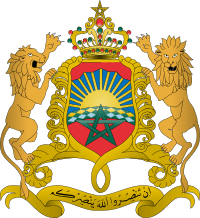Wattasid dynasty
| Wattasid dynasty | |||||
| الوطاسيون - al-waṭṭāsīyūn ⵉⵡⴻⵟⵟⴰⵙⴻⵏ - Iweṭṭāsen | |||||
| Ruling dynasty of Morocco | |||||
| |||||
Map of the Wattasid sultanate (dark red) and its vassal states (light red) | |||||
| Capital | Fes | ||||
| Religion | Sunni Islam | ||||
| Government | Sultanate | ||||
| History | |||||
| • | Established | 1472 | |||
| • | Disestablished | 1554 | |||
The Wattassids (Berber: ⵉⵡⴻⵟⵟⴰⵙⴻⵏ, Iweṭṭasen, Arabic: الوطاسيون, al-waṭṭāsīyūn) were a ruling dynasty of Morocco.
Like the Marinids, they were of Zenata Berber descent.[1] The two families were related, and the Marinids recruited many viziers from the Wattasids.[1] These viziers assumed the powers of the Sultans, seizing power when the last Marinid, Abu Muhammad Abd al-Haqq, who had massacred many of the Wattasids in 1459, was murdered during a popular revolt in Fez in 1465.
Abu Abd Allah al-Sheikh Muhammad ibn Yahya al-Mahdi was the first Wattasid Sultan, but controlled only the northern part of Morocco, the south being divided into several principalities.
The Wattasids were finally supplanted in 1554, after the Battle of Tadla, by the Saadi princes of Tagmadert who had ruled all the South of Morocco since 1511.
Overview
Morocco endured a prolonged multifaceted crisis in the 15th and early 16th centuries brought about by economic, political, social and cultural issues. Population growth remained stagnant and traditional commerce with black Africa was cut off as the Portuguese occupied all seaports. At the same time, the towns were impoverished, and intellectual life was on the decline.
History
Morocco was in decline when the Berber Wattasid dynasty assumed power. The Wattasid family had been the autonomous governors of the eastern Rif since the late 13th century, ruling from their base in Tazouta (near present-day Nador). They had close ties to the Merinid sultans and provided many of the bureacratic elite. While the Merinid tried to repel the Portuguese and Spanish invasions and help the kingdom of Granada to outlive the Reconquista, the Wattasids accumulated absolute power through political maneuvering. When the Merinids became aware of the extent of the conspiracy, they slaughtered the Wattasids, leaving only Abu Abdellah al-Shaykh Muhammad ben Yehya alive. He went on to found the Kingdom of Fez and establish the dynasty to be succeeded by his son, Mohammed al-Burtuqali, in 1504.
The Wattasid rulers failed in their promise to protect Morocco from foreign incursions and the Portuguese increased their presence on Morocco's coast. Mohammad al-Chaykh's son attempted to capture Assilah and Tangiers in 1508, 1511 and 1515, but without success.
In the south, a new dynasty arose: the Saadians who seized Marrakesh in 1524 and made it their capital. By 1537 the Saadians were in the ascendent when they defeated the Portuguese at Agadir. Their military successes contrast with the Wattasid policy of conciliation towards the Catholic kings to the north.
As a result, the people of Morocco tended to regard the Saadians as heroes, making it easier for them to retake the Portuguese strongholds on the coast, including Tangiers, Ceuta and Mazagan. The Saadians also attacked the Watttasids who were forced to yield to the new power. In 1554, as Wattasid towns surrendered, the Wattasid sultan, Abou Hasan Ali, briefly retook Fez. The Saadians quickly settled the matter by killing him and, as the last Wattasids fled Morocco by ship, they too were murdered by pirates.
The Wattasid did little to improve general conditions in Morocco following the Reconquista. It was necessary to wait for the Saadians for order to be reestablished and the expansionist ambitions of the kingdoms of the Iberian peninsula to be curbed.
Coinage
Known Wattasid coins include a few extremely rare gold coins and also square silver dirhams and half dirhams, still following the Almohad standard of roughly 1.5 grams.[2]
The dynasty
Part of a series on the |
|---|
| History of Morocco |
 |
|
Related topics
|
| Morocco portal |
Wattasid Viziers
- 1420-1448 : Abu Zakariya Yahya al-Wattasi
- 1448-1458 : Ali ibn Yusuf
- 1458-1459 : Yahya ibn Abi Zakariya Yahya
Wattasid Sultans
- 1472-1504 : Abu Abd Allah al-Sheikh Muhammad ibn Yahya
- 1504-1526 : Abu Abd Allah al-Burtuqali Muhammad ibn Muhammad
- 1526-1526 : Abu al-Hasan Abu Hasan Ali ibn Muhammad
- 1526-1545 : Abu al-Abbas Ahmad ibn Muhammad
- 1545-1547 : Nasir ad-Din al-Qasri Muhammad ibn Ahmad
- 1547-1549 : Abu al-Abbas Ahmad ibn Muhammad
- 1554-1554 : Abu al-Hasan Abu Hasun Ali ibn Muhammad
Chronology of events
- According to the Treaty of Alcáçovas (1479), and to the Treaty of Tordesillas (1494), Spain recognized the kingdom as being in the Portuguese sphere of influence.
- 1485 Treaty with Spain: The sultanate agrees to not help the Kingdom of Granada, Spain agreed to not capture Moroccan ships in the Alboran Sea.
- 1488 Portuguese conquer Safi
- 1491 Abū `Abd Allāh Muhammed XIII (El Zagal) went to Fez, but was captured and blinded.
- 1492 Arrival of Spanish Muslims and Jews.
- 1497 Spain captures Melilla
- 1502 Portugal captures Mazagan.
- 1505 Portugal captures Agadir.
- 1506 Portugal captures Mogador.
- 1511 Saadians capture Rabat
- 1524 Saadians capture Marrakesh
- 1541 Saadians capture Agadir
- 1541 Saadians capture Safi
- 1542 Hasan Hâsim captures Tetuan
- 1548 The last wattasid king is captured by the Saadians.
- 1550 Saadians conquer Fez.
See also
References
| — Royal house — House of Banu Wattas | ||
| Preceded by Idrisid dynasty Joutey branch |
Ruling house of Morocco 1472 – 1554 |
Succeeded by Saadi dynasty |
| |||||||||||||||||||||||||||||||||||||||||||||||||||||||||||||||